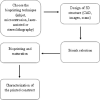Bioprinting and its Use in Tumor-On-A-Chip Technology for Cancer Drug Screening: A Review
- PMID: 36404793
- PMCID: PMC9668576
- DOI: 10.18063/ijb.v8i4.603
Bioprinting and its Use in Tumor-On-A-Chip Technology for Cancer Drug Screening: A Review
Abstract
The rising global incidence of cancer and high attrition rates of anticancer drugs make it imperative to design novel screening platforms to increase the success rate of chemotherapeutic agents. Advances in cell culture models from two-dimensional to three-dimensional platforms, along with microfluidics, have resulted in the creation of tumor-on-a-chip technology, which enables high-throughput molecular screening and helps to simulate the dynamic tumor microenvironment. Furthermore, advancements in bioprinting have allowed the structural and physiological aspects of the tumor to be recreated accurately and help to mimic cell-cell interactions and cell-extracellular matrix. This paper provides a comprehensive review of three-dimensional bioprinting to fabricate a tumor-on-a-chip platform to advance the discovery and screening of anticancer agents and provides a perspective on the challenges and future directions associated with the adoption of this technology to advance cancer research.
Keywords: 3D bioprinting; Anticancer drug screening; Tumor-on-a-chip platform.
Copyright: © 2022 Fang et al.
Conflict of interest statement
The authors declare that they do not have any competing interests.
Figures





Similar articles
-
Microfluidic bioprinting for organ-on-a-chip models.Drug Discov Today. 2019 Jun;24(6):1248-1257. doi: 10.1016/j.drudis.2019.03.025. Epub 2019 Mar 30. Drug Discov Today. 2019. PMID: 30940562 Review.
-
Bioprinting of in vitro tumor models for personalized cancer treatment: a review.Biofabrication. 2020 Jul 9;12(4):042001. doi: 10.1088/1758-5090/ab97c0. Biofabrication. 2020. PMID: 32470967 Review.
-
3D-bioprinted all-inclusive bioanalytical platforms for cell studies.Sci Rep. 2020 Sep 4;10(1):14669. doi: 10.1038/s41598-020-71452-6. Sci Rep. 2020. PMID: 32887912 Free PMC article.
-
3D bioprinting for drug discovery and development in pharmaceutics.Acta Biomater. 2017 Jul 15;57:26-46. doi: 10.1016/j.actbio.2017.05.025. Epub 2017 May 10. Acta Biomater. 2017. PMID: 28501712 Review.
-
Recapitulating Tumorigenesis in vitro: Opportunities and Challenges of 3D Bioprinting.Front Bioeng Biotechnol. 2021 Jun 22;9:682498. doi: 10.3389/fbioe.2021.682498. eCollection 2021. Front Bioeng Biotechnol. 2021. PMID: 34239860 Free PMC article. Review.
Cited by
-
Bioprinting on Organ-on-Chip: Development and Applications.Biosensors (Basel). 2022 Dec 6;12(12):1135. doi: 10.3390/bios12121135. Biosensors (Basel). 2022. PMID: 36551101 Free PMC article. Review.
-
Applications of 3D Bioprinting Technology to Brain Cells and Brain Tumor Models: Special Emphasis to Glioblastoma.ACS Biomater Sci Eng. 2024 May 13;10(5):2616-2635. doi: 10.1021/acsbiomaterials.3c01569. Epub 2024 Apr 25. ACS Biomater Sci Eng. 2024. PMID: 38664996 Free PMC article. Review.
-
Targeted Cancer Therapy-on-A-Chip.Adv Healthc Mater. 2024 Nov;13(29):e2400833. doi: 10.1002/adhm.202400833. Epub 2024 Aug 5. Adv Healthc Mater. 2024. PMID: 39101627 Free PMC article. Review.
-
3D bioprinted tumor model: a prompt and convenient platform for overcoming immunotherapy resistance by recapitulating the tumor microenvironment.Cell Oncol (Dordr). 2024 Aug;47(4):1113-1126. doi: 10.1007/s13402-024-00935-9. Epub 2024 Mar 23. Cell Oncol (Dordr). 2024. PMID: 38520648 Free PMC article. Review.
-
Biosensor-Enhanced Organ-on-a-Chip Models for Investigating Glioblastoma Tumor Microenvironment Dynamics.Sensors (Basel). 2024 Apr 30;24(9):2865. doi: 10.3390/s24092865. Sensors (Basel). 2024. PMID: 38732975 Free PMC article. Review.
References
-
- Bray F, Ferlay J, Soerjomataram I, et al. Global Cancer Statistics 2018:GLOBOCAN Estimates of Incidence and Mortality Worldwide for 36 Cancers in 185 Countries. CA Cancer J Clin. 2018;68:394–424. https://doi.org/10.3322/caac.21492. - PubMed
-
- Sung H, Ferlay J, Siegel RL, et al. Global Cancer Statistics 2020:GLOBACAN Estimates of Incidence and Mortality Worldwide for 36 Cancers in 185 Countries. CA Cancer J Clin. 2021;71:209–49. https://doi.org/10.3322/caac.21660. - PubMed
-
- Ferlay J, Colombet M, Soerjomataram I, et al. Cancer Incidence and Mortality Patterns in Europe:Estimates for 40 Countries and 25 Major Cancers in 2018. Eur J Cancer. 2018;103:356–87. https://doi.org/10.1016/j.ejca.2018.07.005. - PubMed
-
- Stewart B, Wild CP. World Cancer Report 2014. IARC Publication 2014
-
- Knowlton S, Onal S, Yu CH, et al. Bioprinting for Cancer Research. Trends Biote. 2015;33:504–13. - PubMed
LinkOut - more resources
Full Text Sources
